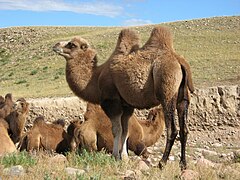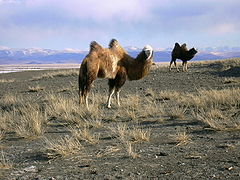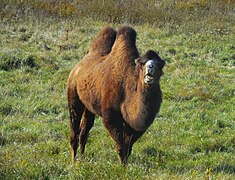Bactrian camel
| Bactrian camel | |
|---|---|

| |
| Shanghai Zoo | |
Domesticated
| |
| Scientific classification | |
| Domain: | Eukaryota |
| Kingdom: | Animalia |
| Phylum: | Chordata |
| Class: | Mammalia |
| Order: | Artiodactyla |
| Family: | Camelidae |
| Genus: | Camelus |
| Species: | C. bactrianus
|
| Binomial name | |
| Camelus bactrianus | |

| |
| Synonyms[1] | |
|
List
| |
The Bactrian camel (Camelus bactrianus), also known as the Mongolian camel, domestic Bactrian camel or two-humped camel, is a large
Domesticated Bactrian camels have served as
Taxonomy
| Phylogenetic relationships of the Camelids from combined analysis of all molecular data.[4] |
The Bactrian camel shares the
In 2007, Peng Cui (of the
The Bactrian camel and the dromedary often interbreed to produce
Differences from wild Bactrian camels
The wild Bactrian camel (Camelus ferus) was first described by Nikolay Przhevalsky in the late 19th century and has now been established as a distinct species from the Bactrian camel (Camelus bactrianus).[12]
Zoological opinion nowadays tends to favour the idea that C. bactrianus and C. dromedarius are descendants of two different subspecies of C. ferus (Peters and von den Driesch 1997: p. 652)[full citation needed] and there is no evidence to suggest that the original range of C. ferus included those parts of Central Asia and Iran where some of the earliest Bactrian remains have been found.[13][full citation needed]
In particular, a population of wild Bactrian camel has been discovered to live within a part of the Gashun Gobi region of the Gobi Desert. This population is distinct from domesticated herds both in genetic makeup[14] and in behavior.[citation needed]
As many as three regions in the genetic makeup are distinctly different from Bactrian camels, with up to a 3% difference in the base genetic code. However, with so few wild camels, what the natural genetic diversity within a population would have been is not clear.[citation needed]
Another difference is the ability of these wild camels to drink saltwater slush, although whether the camel can extract useful water from it is not yet certain. Domesticated camels are unable to drink such salty water.[15]
Description

The Bactrian camel is the largest mammal in its native range and is the largest living camel while being shorter at the shoulder than the dromedary. Shoulder height is from 160 to 180 cm (5.2 to 5.9 ft) with the overall height ranging from 230 to 250 cm (7.5 to 8.2 ft),[16][17][18] head-and-body length is 225–350 cm (7.38–11.48 ft), and the tail length is 35–55 cm (14–22 in). At the top of the humps, the average height is 213 cm (6.99 ft).

Body mass can range from 300 to 1,000 kg (660 to 2,200 lb), with males weighing around 600 kg (1,300 lb), and females around 480 kg (1,060 lb).[19][2][20] Its long, wooly coat varies in colour from dark brown to sandy beige. A mane and beard of long hair occurs on the neck and throat, with hairs measuring up to 25 cm (9.8 in) long.
The shaggy winter coat is shed extremely rapidly, with huge sections peeling off at once, appearing as if sloppily shorn. The two humps on the back are composed of fat (not water as is sometimes thought). The face is typical of a camelid, being long and somewhat triangular, with a split upper lip. The long eyelashes, along with the sealable nostrils, help to keep out dust in the frequent sandstorms which occur in their natural range. The two broad toes on each foot have undivided soles and are able to spread widely as an adaptation to walking on sand. The feet are very tough, as befits an animal of extreme environments.
Natural habitat
These camels are migratory, and their habitat ranges from rocky mountain massifs to flat steppe, arid desert, (mostly the Gobi Desert), stony plains and sand dunes. Conditions are extremely harsh – vegetation is sparse, water sources are limited and temperatures are extreme. The coat of the Bactrian camel can withstand cold as low as −30 °C (−22 °F) in winter to 50 °C (122 °F) in summer.[21] The camels' distribution is linked to the availability of water, with large groups congregating near rivers after rain or at the foot of the mountains, where water can be obtained from springs in the summer months, and in the form of snow during the winter.
Life history

Bactrian camels are exceptionally adept at withstanding wide variations in temperature, ranging from freezing cold to blistering heat. They have a remarkable ability to go without water for months at a time, but when water is available they may drink up to 57 liters at once. When well fed, the humps are plump and erect, but as resources decline, the humps shrink and lean to the side. When moving faster than a
Diet

Bactrian camels are diurnal, sleeping in the open at night and foraging for food during the day. They are primarily herbivorous. With tough mouths that can withstand sharp objects such as thorns, they are able to eat plants that are dry, prickly, salty or bitter, and can ingest virtually any kind of vegetation. When other nutrient sources are not available, these camels may feed on carcasses, gnawing on bones, skin, or various different kinds of flesh. In more extreme conditions, they may eat any material they find, which has included rope, sandals, and even tents. Their ability to feed on a wide range of foods allows them to live in areas with sparse vegetation. The first time food is swallowed, it is not fully chewed. The partly masticated food (called cud) goes into the stomach and later is brought back up for further chewing.
Bactrian camels belong to a fairly small group of animals that regularly eat snow to provide their water needs. Animals living above the snowline may have to do this, as snow and ice can be the only forms of water during winter, and by doing so, their range is greatly enlarged. The latent heat of snow and ice is big compared with the heat capacity of water, forcing animals to eat only small amounts at a time.[22]
Reproduction

Bactrian camels are
Males during mating time are often quite violent and may bite, spit, or attempt to sit on other male camels. The age of
Genome

The Bactrian Camels Genome Sequencing and Analysis Consortium provides a C. bactrianus ferus
Several
Relationship to humans
The Bactrian camel was domesticated circa ~4,500 BCE.

Bactrian camels have been the focus of artwork throughout history. For example, westerners from the Tarim Basin and elsewhere were depicted in numerous ceramic figurines of the Chinese Tang dynasty (618–907).[citation needed]
United States imports
Bactrian camels were imported to the U.S. several times in the mid- to late 1800s, both by the U.S. military and by merchants and miners, looking for pack animals sturdier and hardier than horses and mules. Although the camels met these needs, the
Documentaries
- The Story of the Weeping Camel is a 2003 Mongolian documentary/story about a family of nomadic shepherds trying to get a white calf accepted by his mother, which rejected him after a difficult birth.
Military use
The Indian Army uses these camels to patrol in Ladakh. It was concluded that after carrying out trials and doing a comparative study with a single-humped camel brought from Rajasthan that the double-humped camel is better suited for the task at hand. Colonel Manoj Batra, a veterinary officer of the Indian Army, stated that the double-humped camel "are best suited for these conditions. They can carry loads of 170 kilograms (370 lb) at more than 17,000 feet (5,200 m) which is much more than the ponies that are being used as of now. They can survive without water for at least 72 hours."[30]
Gallery
-
Riding inNubra Valley, India
-
Mongolia
-
Bactrian Camels in the Kyzyl Kum Desert
-
Farm in Central Mongolia
-
Farm in Vermont, US
Footnotes
See also
References
- ^ OCLC 62265494.
- ^ a b "Bactrian camel". EdgeofExistence.org. EDGE. 2010.
- ^ "Quick Facts about Camels' Domestication History". arkbiodiv.com. 2021.
- ^ PMID 17640355.
- ISBN 978-1-4214-0093-8.
- ^ de Buffon, C. (1791). Natural History, General and Particular. Vol. 6. London, UK: Alexander Strahan. p. 121.
- ^ Smith, W.; Anthon, C. (1870). A Dictionary of Greek and Roman Antiquities (3rd ed.). New York, NY: Harper and Brothers Publishers. p. 204.
- ^ Linnaeus, C. (1758). Systema Naturæ per Regna Tria Naturae. Vol. 1 (10th ed.). Stockholm, Sweden: Laurentius salvius. p. 65.
- S2CID 209331892.
- International Livestock Centre for Africa. pp. 1–147.
- S2CID 40857282.
- PMID 24749721.
- ^ Potts (2004), p. 145.
- ^ "Wild camels 'genetically unique'". Earth News. BBC News. 22 July 2009. Retrieved 22 July 2009.
- ^ "Bactrian camels". wildcamels.com. Wild Camel Protection Foundation. 17 May 2010. Retrieved 7 December 2012.
- .
- ^ "Camel fact sheet". Nature. PBS. 2020.
- ^ "Bactrian camel". Dimensions.com.
- S2CID 2219773.
- ^ "Bactrian Camel". UltimateUngulate.com.
- ^ "Bactrian Camel". Highland Wildlife Park. Retrieved 15 July 2022.
- ^ Wand, C.; Richardson, C. (November 2009). "Replacing water with clean snow for ewes and beef cows" (PDF). OMAFRA.gov.on.ca. Ontario Ministry of Agriculture, Food, and Rural Affairs. 9–065 AGDEX 424/433. Archived from the original (PDF) on 2 April 2015. Retrieved 9 February 2017.
- PMID 3900379.
- ^
This review...
Wang, Guo-Dong; Xie, Hai-Bing; Peng, Min-Sheng; Irwin, David; Zhang, Ya-Ping (1 February 2014). "Domestication Genomics: Evidence from Animals". PMID 25384135. ...cites this study: Wang, Zhen; Ding, Guohui; Chen, Gangliang; Sun, Yamin; Sun, Zhihong; Zhang, Heping; Wang, Lei; Hasi, S.; Zhang, Yan; Li, Jianmei; Shi, Yixiang; Xu, Ze; He, Chuan; Yu, Siriguleng; Li, Shengdi; Zhang, Wenbin; Batmunkh, Mijiddorj; Ts, Batsukh; Bat-Ireedui, Shirzana; Gao, Hongwei; Baysgalan, B.; Li, Qing; Jia, Zhi-lei; Wang, Zhaoxia; Wang, Juan; Pan, Lei; Chen, Yongcan; Ganerdene, Yaichil; Liu, Tuya; Cao, M.; He, Fei; Zha-ti, A.; Zheng, Guangyong; Qiu, Feng; Sun, Zikui; Zhao, Lele; Zhao, Wenjing; Liu, Baohong; Li, Chao; Chen, Yun-Qin; Tang, Xiaoyan; Guo, C.; Liu, Wei; Ming, Liang; Cui, Aiying; Li, Yi; Gao, Junhui; Li, Jing; Niu, Shen; Sun, Tao; Zhai, Zhengxiao; Zhang, Min; Chen, Chen; Baldan, T.; Bayaer, Tuman; Li, Yixue; Meng, H.;S2CID 13218949.
- ^ a b
Burger, Pamela Anna (2016). "The history of Old World camelids in the light of molecular genetics". PMID 27048619.
- PMID 27813680.
- ^ a b Rahimdad Khan Molai Shedai; Janat ul Sindh 3rd edition 1993; Sindhi Adbi Board Jamshoro, page 20
- ^ Andrea, A.J.; Levi, S.C. (2009). "Afro-Eurasian connectivity across the ages" (PDF). World System History. The Silk Road. Vol. I.
- ^ Zentner, Joe. "The desert camel experiment". DesertUSA.com and Digital West Media. Retrieved 9 February 2017.
- ^ Bhalla, Abhishek (19 September 2020). "Indian Army to use double-humped camels for transportation, patrolling in Ladakh". India Today.
External links
- "Camelus bactrianus". Animal Diversity project. University of Michigan.
- Handwerk, Brian (3 December 2002) [November 2002]. "Wild Bactrian camels critically endangered, group says". National Geographic. Archived from the original on 6 December 2002.
- "Wild camel protection foundation".
- Sneddon, Aaron. Bactrian Camels at the Highland Wildlife Park, Scotland. flickr.com (images).
- "'New' camel lives on salty water". BBC. 6 February 2001. – BBC announces discovery of camels in the Gashun Gobi region







